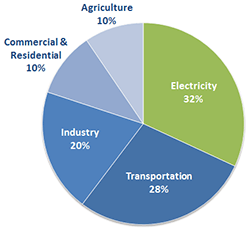Learn About Carbon Pollution From Power Plants
In 2009, EPA determined that greenhouse gas pollution threatens Americans' health and welfare by leading to long lasting changes in our climate that can have a range of negative effects on human health and the environment. Carbon dioxide (CO2) is the primary greenhouse gas pollutant, accounting for nearly three-quarters of global greenhouse gas emissions and 84% of U.S. greenhouse gas emissions.
Carbon pollution and power plants
The electric power sector accounted for 32% of U.S. total greenhouse gas emissions in 2012. Greenhouse gas emissions from electricity have increased by about 11% since 1990 as electricity demand has grown and fossil fuels have remained the dominant source for generation.
Fossil fuel-fired power plants are the largest source of U.S. CO2 emissions. To generate electricity, fossil fuel-fired power plants use natural gas, petroleum, coal or any form of solid, liquid or gaseous fuel derived from such materials.
Health and climate effects of carbon pollution
Climate change is one of the greatest environmental challenges we face. Climate impacts affect all Americans’ lives.
Unchecked carbon pollution leads to long-lasting changes in our climate, such as:
- Rising global temperatures
- Rising sea level
- Changes in weather and precipitation patterns
- Changes in ecosystems, habitats and species diversity
These changes threaten America's health and welfare for current and future generations. Public health risks include:
- More heat waves and drought
- Worsening smog (also called ground-level ozone pollution)
- Increasing the intensity of extreme events, like hurricanes, extreme precipitation and flooding
- Increasing the range of ticks and mosquitoes, which can spread disease such as Lyme disease and West Nile virus
Our most vulnerable citizens, including children, older adults, people with heart or lung disease and people living in poverty may be most at risk from the health impacts of climate change.
2014 was the hottest year in recorded history, and 14 of the 15 warmest years on record have all occurred in the first 15 years of this century. And already, the first half of this year has recorded warmer than normal temperatures.
Overwhelmingly, the best scientists in the world are telling us that our activities are causing climate change – based on troves of data and millions of measurements collected over the course of decades on land, in air and water, at sea and from space.

